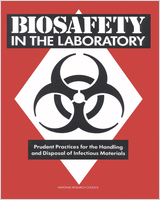Biosafety in the Laboratory is a concise set of practical guidelines for handling and disposing of biohazardous material. The consensus of top experts in laboratory safety, this volume provides the information needed for immediate improvement of safety practices. It discusses high- and low-risk biological agents (including the highest-risk materials handled in labs today), presents the "seven basic rules of biosafety," addresses special issues such as the shipping of dangerous materials, covers waste disposal in detail, offers a checklist for administering laboratory safety--and more.
Support for this project was provided by the U.S. Department of Agriculture and National Institutes of Health under contract no. 59-32U4-5-33; the U.S. Department of the Army under contract no. DAMD17-86-G-6022; the U.S. Department of Energy under grant no. DE-FG05-85ER13457; the U.S. Department of Labor under purchase order no. B9F56292; and the National Science Foundation under grant no. DMB-8611553. The project has also been supported by funds from the National Research Council Fund, a pool of private, discretionary, nonfederal funds that is used to support a program of Academy-initiated studies of national issues in which science and technology figure significantly. The NRC Fund consists of contributions from a consortium of private foundations including the Carnegie Corporation of New York, the Charles E. Culpeper Foundation, the William and Flora Hewlett Foundation, the John D. and Catherine T. MacArthur Foundation, the Andrew W. Mellon Foundation, the Rockefeller Foundation, and the Alfred P. Sloan Foundation, as well as the Academy Industry Program, which seeks annual contributions from companies that are concerned with the health of U.S. science and technology and with public policy issues with technological content.
NOTICE: The project that is the subject of this report was approved by the Governing Board of the National Academy of Sciences, the National Academy of Engineering, and the Institute of Medicine. The members of the committee responsible for the report were chosen for their special competences and with regard for appropriate balance.
This report has been reviewed by a group other than the authors according to procedures approved by a Report Review Committee consisting of members of the National Academy of Sciences, the National Academy of Engineering, and the Institute of Medicine.
The National Academy of Sciences is a private, nonprofit, self-perpetuating society of distinguished scholars engaged in scientific and engineering research, dedicated to the furtherance of science and technology and to their use for the general welfare. Upon the authority of the charter granted to it by the Congress in 1863, the Academy has a mandate that requires it to advise the federal government on scientific and technical matters. Dr. Frank Press is the president of the National Academy of Sciences.
The National Academy of Engineering was established in 1964, under the charter of the National Academy of Sciences, as a parallel organization of outstanding engineers. It is autonomous in its administration and in the selection of its members, sharing with the National Academy of Sciences the responsibility for advising the federal government. The National Academy of Engineering also sponsors engineering programs aimed at meeting national needs, encourages education and research, and recognizes the superior achievements of engineers. Dr. Robert M. White is president of the National Academy of Engineering.
The Institute of Medicine was established in 1970 by the National Academy of Sciences to secure the services of eminent members of appropriate professions in the examination of policy matters pertaining to the health of the public. The Institute acts under the responsibility given to the National Academy of Sciences by its congressional charter to be an adviser to the federal government and, upon its own initiative, to identify issues of medical care, research, and education. Dr. Samuel O. Thier is president of the Institute of Medicine.
The National Research Council was organized by the National Academy of Sciences in 1916 to associate the broad community of science and technology with the Academy's purpose of furthering knowledge and advising the federal government. Functioning in accordance with general policies determined by the Academy, the Council has become the principal operating agency of both the National Academy of Sciences and the National Academy of Engineering in providing services to the government, the public, and the scientific and engineering communities. The Council is administered jointly by both Academies and the Institute of Medicine. Dr. Frank Press and Dr. Robert M. White are chairman and vice chairman, respectively, of the National Research Council.
